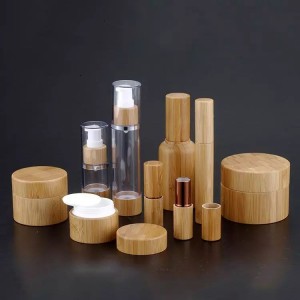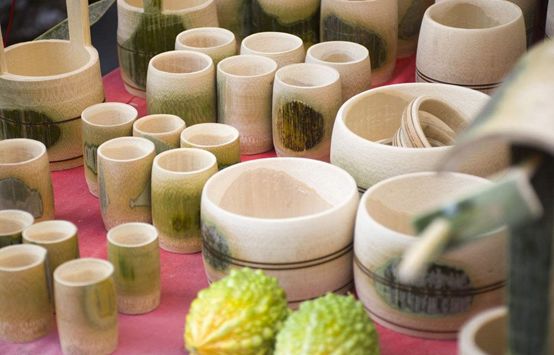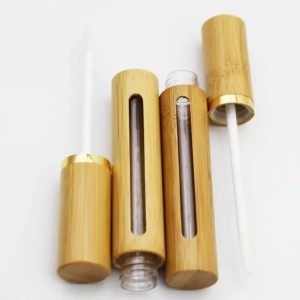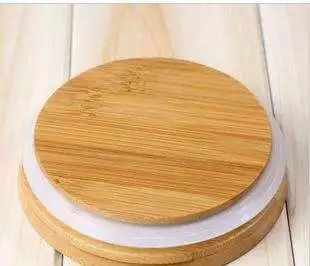As cosmetic packaging innovation attracts more and more attention from brands, the innovation models of packaging materials have also become diverse, ranging from modeling innovation to structural and functional innovation, as well as the current cross-border combination innovation of packaging materials and instruments. , different packaging material innovation models have opened up creative sources for brand innovation. As packaging materials, environmentally friendly materials have always been favored by brands and consumers, such as bamboo and wood packaging materials. At this stage, bamboo and wood packaging materials have been fully integrated into cosmetics. Bamboo and wood packaging materials are used in the packaging material family, ranging from lipstick tubes, bottle caps, bottle jackets, etc. In this article, we will learn some information about bamboo and wood products with you.
1.Learn about bamboo and wood products

Bamboo and wood products refer to products made by wood products processing factories using bamboo as processing raw materials. They are mostly daily necessities, such as bamboo baskets, bamboo sieves, bamboo fences, bamboo dustpans, bamboo steamers, cooking brooms, bamboo dustpans, bamboo dust buckets, and bamboo rakes. , baskets, bamboo poles, bamboo chopsticks, bamboo brooms, bamboo hats, bamboo plaques, bamboo back baskets, bamboo mats, bamboo mats, bamboo beds, bamboo stools, bamboo chairs, bamboo lounge chairs, cutting boards, mats, tea coasters, curtains, etc., in recent years There are more popular bamboo flooring and bamboo furniture, as well as some high-value wooden handicrafts, such as bamboo carvings and other
2.folk handicrafts.
1. Advantages:
● Prevent rheumatoid arthritis. Bamboo has the ability to automatically adjust and maintain temperature. It does not cool or release heat, and is warm in winter and cool in summer.
● Healthy eyesight. The texture of bamboo has the function of absorbing ultraviolet rays. The color is elegant, soft and warm, which is beneficial to human vision and can reduce the occurrence of myopia.
● Reduce noise. Bamboo itself has the functions of sound absorption, sound insulation, reducing sound pressure and shortening the residual sound time.
● Avoid allergic asthma. After bamboo is steamed, bleached, and carbonized at high temperatures, all nutrients in the bamboo fibers are removed, completely destroying the living conditions for moths and bacteria, preventing mildew, and reducing the occurrence of asthma and allergies.
● Natural characteristics. Bamboo, like people, is a natural life form, and the texture of bamboo has regular changes in irregularities. The natural color and special texture of bamboo are just like the poet Su Dongpo of the Song Dynasty "I would rather eat without meat than live without bamboo." . Natural materials are a symbol of elegance and preciousness. It exudes natural fragrance, beautiful bamboo texture, and also emits fresh and fragrant gas, which is beneficial to physical and mental health.
2. Disadvantages:
● It is prone to insects and mold, and will be deformed and cracked by the environment.
● Most of them are hand-woven and not as tight as steel wooden furniture.
3.Material selection for bamboo and wood products

The production of wooden handicrafts is very particular about the selection of bamboo materials. Generally, you go to the mountains after winter, before spring, when the weather is fine, and prepare two large iron pots, some caustic soda, bamboo knives, axes, curium and other tools. It is best to choose two bamboo Those over 10 years old, too young or too old are not advisable. When selecting bamboo, only take five or six knots from the middle section of the bamboo, and choose one with a smooth surface, no scabs and no injuries. After felling, you must also pay attention to protection. Once injured, there is no way to recover. To make a pen holder, you can choose one close to the root. Cut the length first. The length of the pen holder is generally about 12 centimeters. It will be difficult to use if it is more than 15 or 6 centimeters. You can choose the armrest material that is as long as possible. After cutting down the bamboo, immediately set up a pot, boil water, add caustic soda, and simmer over low heat for a long time, like the Cantonese people making soup stock. During this period, you must constantly scoop out the bamboo juice on the water. After a few hours, take out the bamboo tube and bamboo slices from the heat, wipe off the bamboo juice on the surface, immediately put them in another pot of boiling water, and continue cooking. Each pot takes about three hours. After the time is up, don't rush to take it out. Wait until the water gradually warms up, then wipe the surface clean, and cover the bamboo skin side with thick paper to protect it from scratches. Every time you cut bamboo, try to take as much as possible, because the loss will be greater later, so the focus of material selection is
● Bamboo is more than two years old and old bamboo has poor toughness.
● The thickness and thickness of the bamboo wall should be appropriate. Thicker is not always better.
● Protect the original green skin of the bamboo. If the green skin is damaged, it cannot be repaired, and it will cause color difference on the bamboo surface in the future.
● Opening the pieces in time can release the tension of the bamboo and allow the fibers to have room to shrink.
● Grasp the boiling time. After opening the slices, put it in the pot as soon as possible. Do not wait until it goes down the mountain before cooking (the bambooware is infested with insects, cracks, and mildew, which are all caused by not handling it in time)
After cutting the bamboo and returning home, spread it out to dry in the shade for several days. Be careful to prevent moisture and mildew. Then take advantage of the winter sunshine and bask in it! Leave it in the sun until the beginning of spring. If problems such as cracking occur during this period, discard it. After the beginning of spring. Store the dried bamboo in a cool, dry place and pay attention to ventilation. Take it out for inspection every year and keep it for more than three years. If it is not bad, you can use it with confidence. Such material is as strong as jade and will turn red over time. It is a rare treasure.
4.Processing of bamboo and wood products

A method of making patterns for bamboo products. According to the different layers of bamboo slices used in the bamboo products, the first layer is Guaqing (including top green), the second and third layers are second green, and different methods are used to make patterns respectively. Guaqing (including Guaqing) The production of bamboo product patterns is to place the bamboo product flat in a magnetic field with a magnetic induction intensity of 0.5-1.5T, and cover the bamboo product with an acid-resistant and deformation-resistant art mold (negative mold) carved with various patterns. , spray nitric acid (or a mixture of nitrate and other strong acids) or sulfuric acid or a mixture of nitric acid and sulfuric acid with various concentrations of 5-65% (weight percent concentration) onto the pattern of the mold, and the acid passes through the engraved pattern of the positive mold. On bamboo chips, you can also directly use the above-mentioned acid solution to draw on the product without using a mold, and then bake it at a controlled temperature of 80°C-120°C for 3-5 minutes to cause an esterification reaction between the acid solution and bamboo fiber, thereby making the bamboo products Showing beautiful patterns of different shades that do not fade; the pattern of Erqing bamboo products is made by placing the bamboo products flat in a magnetic field with a magnetic induction intensity of 0.5-1.5T, and using corrosion-resistant art molds engraved with various patterns (Mold) is covered on the Erqing bamboo product, and then the following processes are performed:
a. Spray 1% (weight percentage concentration) dioctyl sulfosuccinate sodium salt rapid penetrating agent onto the entire bamboo product and mold;
b. Then spray a highly corrosive acidic or alkaline or salt solution. The concentration of the solution depends on the pattern requirements;
c. Spray the color fixing agent hexahydro-1, 3, 5-triacryloyltriazine (concentration is 1% by weight);
d. Spray nitrocellulose varnish;
e. Remove the mold and obtain a pattern with dark surroundings and the original color of the bamboo (mat) product.
5.Quality control of bamboo and wood products
Bamboo and wood products are my country's bulk export agricultural products. Safety and health issues related to the production of bamboo and wood handicrafts and paint-based bamboo and wood products have also attracted increasing attention from relevant countries, and the situation is very serious. There are also some problems that can easily lead to unstable product quality and lead to products carrying harmful organisms.
At present, the main methods for killing harmful organisms in wood and bamboo include fumigation and heat treatment. Bamboo and wood product processing plants must have a drying process during the production and processing process. As long as key indicators such as temperature, humidity and time are properly controlled, the purpose of harmful treatment can also be achieved. Therefore, heat treatment can be used as an effective method for wood product companies to eliminate harmful effects. Preferred method. Some companies are equipped with wood drying equipment, but in order to remove moisture from the wood while reducing cracking and deformation, companies generally use low-temperature drying. However, this treatment method is far from meeting the treatment requirements of killing harmful organisms using high temperature and high humidity, and can easily lead to mold and insect growth in the finished product.
Anti-mold doctors believe that mildew prevention mainly focuses on raw material processing and finished product protection. Raw material processing mainly involves anti-mold treatment of bamboo wood that has not yet been deeply processed. Generally, it is soaked with bamboo wood anti-fungal agent and allowed to air dry for 5 to 10 minutes. That is, let the anti-mildew factors adhere to these bamboo and wood materials that have not been deeply processed. After drying and processing, the products will have anti-mildew functions.
The other is the treatment of the finished product. If the raw materials have been treated, the finished product will have anti-mold function, and there is no need to carry out anti-mold treatment again. However, for finished bamboo and wooden handicrafts made without treatment, We also need to carry out anti-mildew treatment. This mainly involves surface treatment of the product and control of the packaging environment. Surface treatment mainly involves spraying the surface of the finished product with bamboo anti-mildew spray to form an anti-mildew protective layer on the surface of the product to protect it from mold. infringement. The main control of the replacement environment is that the product needs to have a good environment in a relatively sealed space, with low relative humidity and an environment full of anti-mildew factors. This can also be done easily. Put a label on the product packaging. Biochemical desiccant, according to the size of the product, you can choose appropriate specifications such as 1G, 2G, 4G, 10G, etc. The anti-mildew tablets produced using slow-release technology can well maintain the anti-mildew environment. You can also choose different specifications according to different products. It can easily control relative humidity, maintain a mildew-proof space, and protect products from mold within 6 months.
Post time: Apr-17-2024


